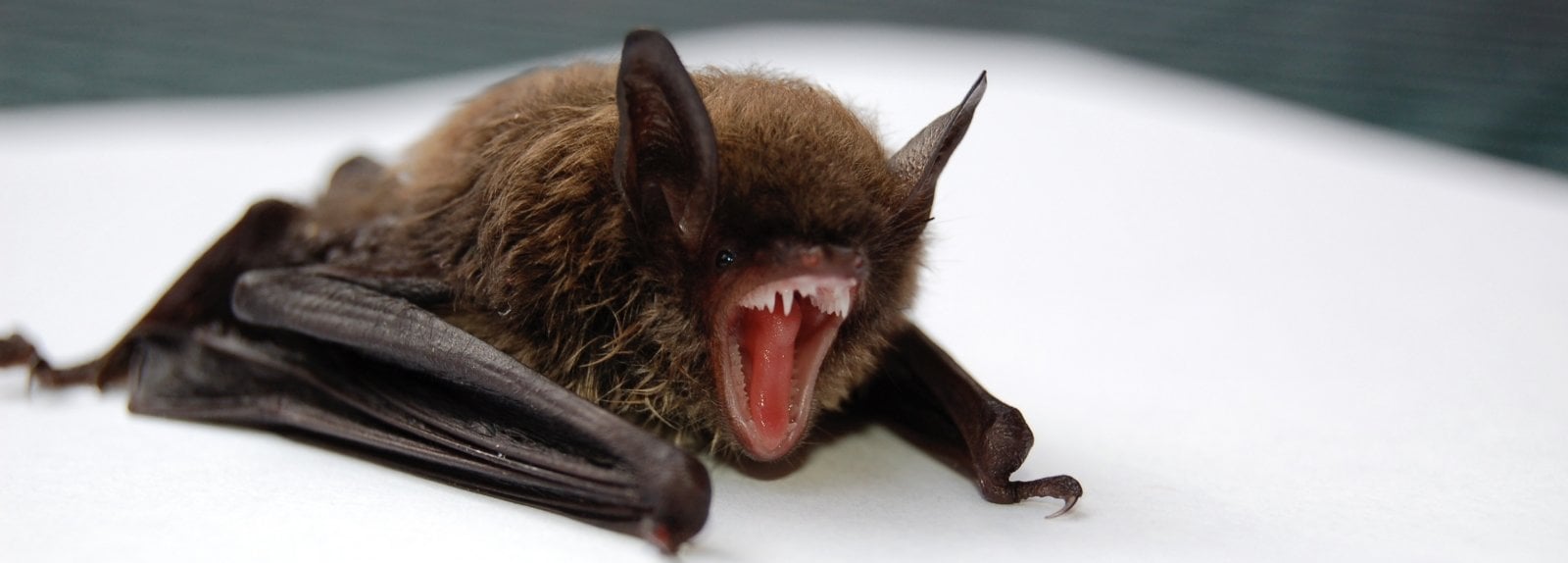Little Brown Bat (Myotis lucifugus/ M. lucifugus)
Image Source: batcon.org
Kingdom
Animalia
Phylum
Chordata
Subphylum
Vertebrata
Class
Mammalia
Order
Chiroptera
Family
Vespertilionidae
Genus
Myotis
Species
Myotis lucifugus
Here’s a Quick Summary of Our Key Findings:

Geographical Range
Little brown bats, Myotis lucifugus, are common in southern Alaska, Canada, and the higher elevation forested regions of Mexico.
Little brown bats have been seen in Iceland and Kamchatka, despite the fact that they are not found in northern Canada.
Those off-the-beaten-path records are thought to be the result of accidental transportation via ship.
Little brown bats are extremely common in Michigan.
Little brown bats are also rare in parts of Florida, the southern Great Plains of the United States, southern California, and coast Virginia and the Carolinas.
Habitat
Little brown bats occupy 3 types of roosts: day, night, and hibernation roosts.
The presence of stable ambient temperatures is used to determine where roosts should be built.
Night roosts are chosen for their confined spaces, which allow large numbers of bats to congregate and raise the roost’s temperature.
During the spring, summer, and fall, day and night roosts are used, while hibernacula sites are used during the winter months.
Myotis yumanensis may share hibernaculum sites.
Bats hibernate from early September to mid-May in the north, and from November to mid-March in the south.
During the changing of the seasons, Myotis lucifugus does not migrate for long distances. Little brown bats can be found in a wide range of latitudes and elevations.
Physical Description
Myotis lucifugus has a glossy coat that ranges in color from dark brown to golden brown, reddish brown, and olive brown.
The ears of Myotis lucifugus are small, and the hind feet are large.
Five metapodials are found on the fore and hind limbs.
Myotis lucifugus has an upslope profile of the forehead, a shortened rostrum, 38 teeth, and no sagittal crest.
The calcar of Myotis lucifugus lacks a keel, and the tibia is short in comparison to the length of the hind foot (55 percent of the tibial length).
Little brown bats can reach speeds of up to 21 mph, with an average of 12.5 mph.
Females are generally larger than males, particularly in the winter.
Reproduction
There are two stages to mating: active and passive.
Males mate with multiple females in both active and passive phase mating.
Swarming M. lucifugus can travel long distances, mixing populations from various locations.
Little brown bats are receptive to calls from conspecifics during the swarming period.
During the mating season, Myotis lucifugus has enlarged perirhinal glands.
Between copulations in the fall and fertilization in the spring, little brown bats delay ovulation and store sperm for about seven months.
When the pups start to fly and become self-sufficient at around 4 weeks of age, they are no longer dependent on their mother.
Spermatogenesis takes place from May to August.
Lifespan & Longevity
M. lucifugus’ lifespan is extended by their ability to find food and roost in a variety of locations.
Myotis lucifugus live for about 6 to 7 years, but they can live for up to 10 years.
In southeastern Ontario, a 31-year-old male was discovered.
During the first winter, when new pups have significantly less weight than their adult counterparts at the start of hibernation, the mortality rate is highest.
Typical Behavior
Little brown bats are nocturnal creatures who leave their roosts at dusk.
The length of hibernation in the winter is determined by the altitude and location of the roosts.
For hibernation roosts, Myotis lucifugus does not migrate long distances.
Little brown bats go into torpor for 12 to 19 days at a time during hibernation, but they can stay torpid for up to 83 days.
Weather conditions in the area, as well as arousal of nearby bats, are indicators that hibernation is coming to an end.
Little brown bats have a wide range of body temperatures.
In low humidity environments with limited water supply, Myotis lucifugus occults can increase urine concentration to better withstand water stress.
In general, the little brown bat prefers to live near bodies of water.
Eating Habits
Myotis lucifugus is a good insect predator, especially when there are a lot of insects in a small area (approximately less than one mile).
Myotis lucifugus feeds on swarms of insects to save time and energy on food hunting.
Food is chewed and processed quickly by Myotis lucifugus.
Both flying and stationary insects are located using the same FM call.
Myotis lucifugus catches free-flying insects in wooded areas, fields, and over water, but it also eats insects on the surface of the water.
Swooping or dipping maneuvers are used to catch insects in flight.
Little brown bats eat a lot of insects that live in the water.
Beetles can be easily identified and captured using echolocation when it is available.
Positives and Negatives With Humans
Members of this species are heavily researched and provide scientists with a bat model to test and study many aspects of the order, including echolocation, social behavior, feeding, and habitat use.
Additionally, little brown bats eat pests that transmit diseases and eat agricultural products.
They are also predators of mosquitoes and other pest around human habitats.
Myotis lucifugus is the target of bat control measures due to the abundance of the species.
These bats inhabit attics, roofs, trees, and other areas in close proximity to humans; therefore, homeowners have spent large amounts of money trying to eradicate M. lucifugus from these areas.
Rabies transmission to humans is extremely low, and only a small percentage of M. lucifugus are infected with the disease.
Although rabies in M. lucifugus is low, other parasites such as tapeworms, fleas, mites and bed bugs are common.
References
Havens, A. 2006. “Myotis lucifugus” (On-line), Animal Diversity Web. Accessed September 21, 2021 at https://animaldiversity.org/accounts/Myotis_lucifugus/
Bassett, J., J. Wiebers. 1979. Subspecific Differences in the Urine Concentrating Ability of Myotis lucifugus. Journal of Mammalogy, 60(2): 395-397.
Belwood, J., M. Fenton. 1976. Variation in the diet of Myotis lucifugus (Chiroptera:Vespertilionidae). Canadian Journal of Zoology, 54: 1674-1678.
Cockrum, E. 1956. Homing, movements and longevity of bats. J. Mammal, 37: 48-57.
Cryan, P. 2010. “White-nose syndrome threatens the survival of hibernating bats in North America” (On-line). U.S. Geological Survey, Fort Collins Science Center. Accessed September 16, 2010.
Fenton, M., R. Barclay. 1980. Myotis lucifugus. Mammalian Species, 142: 1-8.
Fenton, M., G. Bell. 1979. Echolocation and feeding behaviour in four species of g.Myotis (Chiroptera). Canadian Journal of Zoology, 57: 1271-1277.
Kunz, T., E. Anthony, W. Rumage III. 1977. Mortality of little brown bats. J. Wildl. Manage, 41: 476-483.
Kurta, A. 1995. Mammals of the Great Lakes Region. Ann Arbor, MI: The University of Michigan Press.
Kurta, A., T. Kunz. 1988. Roosting Metabolic Rate and Body Tempature of Male Little Brown Bats (Myotis lucifugus) in Summer. Journal of Mammalogy, 69(3): 645-651.

